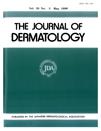A Case of Metastatic Extramammary Paget's Disease That Responded to Combination Chemotherapy
Abstract
Extramammary Paget's disease is considered to be a malignant tumor originating from the sweat glands. Some cases of extramammary Paget's disease infiltrate the dermis and metastasize to the regional lymph nodes. No standard treatment has been established for advanced cases. Few previous studies of the treatment for metastatic Paget's disease have revealed an effective regimen. The prognosis of metastasized cases is very poor.
We encountered a patient in whom extramammary Paget's disease had metastasized to the lymph nodes beyond the regional lymph nodes and systemic chemotherapy was partially effective. Combination chemotherapy consisted of mitomycin C 3.5 mg/m2 and epirubicin 50 mg/m2 on day 1, vincristine 0.6 mg/m2 on days 1 and 7, cisplatin 30 mg/m2 from days 1 to 3, and 5-fluorouracil 350 mg/m2 from days 3 to 7. After two courses of chemotherapy, the metastatic lymph nodes decreased in size by more than 90% compared to that before chemotherapy. We defined the treatment effect of this regimen as a partial response (PR). Microscopic examination of the resected lymph nodes revealed replacement of metastatic lesions by fibrous tissue, suggesting a therapeutic effect. Anorexia, alopecia, and leukopenia (neutropenia) have been reported as toxicities, but all were tolerated.
Our results may provide useful indications for the management of this tumor. This particular combination chemotherapy is recommended for extramammary Paget's disease patients with systemic nodal metastases.




